Murine monoclonal antibody (MoAb) Lym-1 is an IgG2a able to bind HLA-DR variants on malignant B cells and suitable for serotherapeutic approaches in B-lymphoma patients. We have previously shown that Lym-1 can synergize with granulocyte-macrophage colony-stimulating factor (GM-CSF) to trigger neutrophil cytolysis towards Raji cells used as a model of B-lymphoma targets. Here we provide evidence for the intervention of certain neutrophil receptors or surface molecules in this model of cell-mediated lysis. The lysis was completely inhibited by the anti-FcγRII MoAb IV.3 and unaffected by the anti-FcγRIII MoAb 3G8. This suggests that neutrophil cytolysis involves FcγRII without cooperation of this receptor with FcγRIII. Moreover, the lysis was inhibited by an anti-CD18 MoAb (MEM48) and by a MoAb specific for carcinoembryonic antigen (CEA)-like and glycophosphatidyl inositol (GPI)-linked glycoproteins (CD66b). Using an immunofluorescence staining procedure, cross-linking of CD66b induced the redistribution of CD11b on neutrophils with distinct areas of CD11b clustering via a process susceptible of inhibition by D-mannose. This is consistent with the ability of CD11b-CD18 and CD66b to undergo lectin-like physical interactions on the neutrophil surface. Such a type of interaction is presumably instrumental for neutrophil cytolytic activity in that the lysis was inhibited by D-mannose and enhanced by the MoAb VIM-12, which mimics the cooperation between CD11b and GPI-anchored molecules by specifically interacting with CD11b lectin-like sites. Therefore, the present results prove the absolute requirement for FcγRII in neutrophil GM-CSF/Lym-1–mediated cytolysis and, on the other hand, define the crucial role of CD66b and CD11b/CD18 in the expression of the cell lytic potential.
A PRELIMINARY CLINICAL trial with intravenous infusion of the monoclonal antibody (MoAb) Lym-1 performed in patients with refractory lymphoma has shown evident reduction of lymph node size only in some cases.1 Although various factors, including a relative inadequacy of the host immune effector systems, are likely to be responsible for these partial responses,1,2 there are some reasons for taking an interest in the activity of this MoAb. Firstly, Lym-1 is a murine IgG2a MoAb that recognizes a polymorphic variant of HLA-DR antigens present on the membrane of B-lymphoma cells and incapable of shedding or undergoing modulation after antibody binding.3 Secondly, in vivo studies with radiolabeled Lym-1 have shown antibody localization at sites of lymphomatous disease,4 the reactivity of normal tissue cells including B lymphocytes being very low or absent.3 Finally, using Raji cells as a model of B-lymphoma targets, interleukin-2 and γ-interferon were found to increase Lym-1 antibody-dependent cytolysis (ADCC) by mononuclear cells5,6 and by neutrophils,7 8 respectively, suggesting that the above-mentioned inadequacy of the immune effector systems in lymphoma patients might be susceptible to improvement.
Consistent with the attractive possibility of augmenting antitumor immune effectors, we have recently shown that a variety of cytokines and chemotaxins synergize with Lym-1 to greatly amplify the ADCC activity of neutrophils towards Raji target cells.9 In this context, granulocyte-macrophage colony-stimulating factor (GM-CSF) has been shown to synergize with Lym-1 to induce ADCC by macrophages,10 as well as neutrophils.9 These findings, coupled with the capacity of GM-CSF to increase phagocyte production and survival,11,12 make the cytokine an attractive candidate to further develop Lym-1 antibody-based approaches to the therapy of lymphomas. Despite these perspectives, no report is presently available on the mechanisms of phagocyte-mediated, GM-CSF/Lym-1 synergistic stimulation of cytolytic activity. Moreover, few reports deal with the mechanism of neutrophil-mediated MoAb-dependent ADCC in general. In this regard, using melanoma and neuroblastoma cell lines and a murine antitarget monoclonal IgG3, neutrophil-mediated tumor lysis was found to be strictly related to the intervention of neutrophil Fcγ receptor type II (FcγRII), FcγRIII, and adhesion molecules CD11b-CD18.13
The present study shows that neutrophil-mediated GM-CSF/Lym-1 ADCC absolutely requires FcγRII without the contribution of FcγRIII. Moreover, the cytolytic process involves CD11b-CD18 integrins, which presumably undergo physical association with CD66b molecules via lectin-like interactions.
MATERIALS AND METHODS
Culture medium and reagents.
The following culture medium was used: RPMI 1640 (Irvine Scientific, Santa Ana, CA) supplemented with 10% heat-inactivated (56°C, 45 minutes) fetal calf serum (FCS, HyClone Eur, Ltd, Cramlington, NE), and 2 mmol/L glutamine (Irvine Scientific) (RPMI-FCS). Hanks’ Balanced Salt Solution (HBSS) was from Irvine Scientific. Ficoll-Hypaque was purchased from Seromed, Berlin, Germany. Sodium chromate51Cr was from the Radiochemical Center, Amersham, England. Triton X-100, ethidium bromide, D-mannose, N-acetyl-D-glucosamine (NADG), galactose, sodium azide, and fluorescein diacetate were purchased from Sigma Chemical Co, St Louis, MO. Heparin was obtained from Roche, Milano, Italy. Human recombinant GM-CSF was from Genzyme, Cambridge, MA.
MoAbs.
The previously described9 MoAb, Lym-1 (IgG2a), was used as antitarget MoAb for the cytolytic assay. Moreover, the following MoAbs were used: anti-CD32 IV.3 (Fab fragments, Medarex, West Lebanon, NH), anti-CD16 3G8 [F(ab)2 fragments, Medarex], anti-CD18 MHM23 (IgG1, Dako AS, Glostrup, Denmark), anti-CD18 MEM48 (IgG1, kindly provided by V. Horejsi, Praha, Institute of Molecular Genetics, Academy of Science, Prague, Czech Republic), anti-CD18 60.3 (IgG2a, kindly provided by J. Harlan, Department of Medicine, University of Washington, Harborview Medical Center, Seattle, WA), anti-CD11a MEM25 (IgG1, kindly provided by V. Horejsi, Praha), anti-CD11b 2LPM19c (IgG1, Dako AS), anti-CD11b 44 (IgG1, BioSource, Camarillo, CA), anti-CD11b CBRM 1/5 (IgG1, kindly provided by T.A. Springer, Department of Pathology, Harvard Medical School, Boston, MA), anti-CD11c 3.9 (IgG1, BioSource), antiCD11c KB90 (IgG1, Dako AS), anti-intercellular adhesion molecule (ICAM)-1 84H10 (IgG1, Immunotech, Marseille, France), anti-CD11b VIM12 (IgG1, kindly provided by W. Knapp, Institute for Immunology, The University of Vienna, Vienna, Austria), anti-CD66b 80H3 (IgG1, Serotec–Valter Occhiena, Torino, Italy). Fluorescein isothiocyanate (FITC)-conjugated anti-CD11b (44, IgG1) was from Biosource. FITC-conjugated anti-CD10 (ALB2, IgG2a), FITC-conjugated anti-CD14 RMO52, FITC-conjugated anti-CD16 3G8, FITC-conjugated anti-CD32 2E1, FITC-conjugated anti-CD64 22 were from Immunotech. The appropriate control isotype-matched FITC-MoAbs were from Immunotech. The goat antimouse (F[ab]2 fragments) was purchased from BioSource.
Neutrophil preparation.
Heparinized venous blood (heparin 10 U/mL) was obtained from healthy volunteers (20 to 37 years old) after informed consent. No donor had an infectious disease or was under medication at the time of and for 2 weeks before sampling. Neutrophils were prepared by dextran sedimentation, followed by centrifugation (400g, 30 minutes) on a Ficoll-Hypaque density gradient, as previously described.9 Contaminating erythrocytes were removed by hypotonic lysis.9 Neutrophils resuspended in RPMI-FCS were > 97% pure and > 98% viable, as determined by assays previously described.9 Morphologic and phenotypic characteristics of cell preparations used are shown in Table 1.
Characteristics of Effector Cell Populations
| Morphology* . | ||||
|---|---|---|---|---|
| Neutrophils . | Lymphocytes . | Monocytes . | Eosinophils . | Basophils . |
| 97.5 | 0.5 | 0.5 | 1.5 | 0 |
| (97-99) | (0-1) | (0-1) | (0.5-2) | (0) |
| Phenotype† | ||||
| CD11b | CD16 | CD32 | CD64 | CD14 |
| 98 | 97.5 | 99 | 0.5 | 0.5 |
| (96-100) | (97-100) | (98-100) | (0-1) | (0-1) |
| Morphology* . | ||||
|---|---|---|---|---|
| Neutrophils . | Lymphocytes . | Monocytes . | Eosinophils . | Basophils . |
| 97.5 | 0.5 | 0.5 | 1.5 | 0 |
| (97-99) | (0-1) | (0-1) | (0.5-2) | (0) |
| Phenotype† | ||||
| CD11b | CD16 | CD32 | CD64 | CD14 |
| 98 | 97.5 | 99 | 0.5 | 0.5 |
| (96-100) | (97-100) | (98-100) | (0-1) | (0-1) |
Results are expressed as percentage (mean with range in parenthesis) of cells calculated after morphologic evaluation of at least 200 cells on cytopreps stained with May-Grünwald-Giemsa (n = 4).
Results are expressed as percentage (mean with range in parenthesis) of cells that stained positively in flow cytometric assessment (n = 4).
Target cells.
Lymphoblastoid Raji cells9 were used as targets in the cytolytic assays. The Raji cell line was grown in RPMI-FCS and subcultured every 3 days. The capacity of these cells to bind Lym-1 antibody was measured by indirect immunofluorescence with flow cytometry using a rabbit antimouse IgG F(ab′)2polyclonal antibody conjugated with FITC (Dako).9 For cytolytic assays, 4 × 106 Raji cells were labeled with 100 to 200 μCi sodium chromate 51Cr by incubating for 1 hour at 37°C (final volume, 0.5 mL; medium, RPMI 1640 plus 5% FCS). After washing, labeled cells were resuspended in RPMI-FCS.
Cytolytic assays.
Cytolytic activity of neutrophils was measured as described elsewhere in detail.9 Briefly, target cells (2 × 104) were mixed with neutrophils at an effector:target ratio of 20:1, with and without Lym-1 MoAb and/or GM-CSF appropriately diluted in RPMI-FCS. The effector:target ratio of 20:1 was chosen on the basis of preliminary experiments. Experiments were performed in the absence or presence of the various MoAbs and reagents used to probe the cytolytic process. The assays were performed in triplicate and in a final volume of 150 μL using round-bottom microplates (Falcon, Becton-Dickinson Italia, Milano, Italy). After a 14-hour incubation in humidified atmosphere of 95% air and 5% CO2, the51Cr-release was determined in the cell-free supernatants. The percentage of cytolysis was calculated according to the formula 100 × (E-S)/(T-S), where E is the cpm released in the presence of effector cells, T is the cpm released after lysing target cells with 5% triton X-100, and S is the cpm spontaneously released by target cells incubated with medium alone (<18%).
Immunofluorescence neutrophil staining.
Purified neutrophils (1 × 106 cells in HBSS) were incubated for 30 minutes at 4°C in the presence or absence of 4 μg/mL anti-CD66b MoAb 80H3. After washing twice with cold HBSS, the cells were incubated (30 minutes, 4°C) with 20 μg/mL goat antimouse F(ab′)2. The cells were washed with HBSS containing 0.1% sodium azide and then incubated (30 minutes, 37°C) with FITC-conjugated anti-CD11b MoAb 44 or anti-CD10 MoAb ALB2. In some experiments, the entire procedure was performed in the presence of 100 mmol/L D-mannose. The cells were examined using a fluorescence Nikon Optiphot-2 microscope (Nikon, Melville, NY) and images were collected by a Hamamatsu Color-chilled 3 CCD camera (Hamamatsu Italia, Arese, Italy).
Statistical analysis.
Each data point represents the mean of the results obtained by testing each donor in triplicate. When present, the line graphs represent single experiments performed in triplicate from different donors. The standard deviation (SD) of triplicate samples was always <10%. Results were expressed as mean ± 1 SD and/or as median with the 95% confidence interval. Statistical differences were analyzed by the nonparametric Mann-Whitney U test. Significance was accepted when P < .05.
RESULTS
Synergistic stimulation of neutrophil lytic activity by Lym-1 MoAb and GM-CSF.
Human neutrophils, incubated with 51Cr-labeled Raji cells, were incapable of inducing target cell lysis as detected by the release of the radiolabel (Fig 1). The addition of 1 ng/mL GM-CSF did not affect the phenomenon (Fig 1). As compared with neutrophil-Raji cell coincubation in its absence, 10 μg/mL Lym-1 MoAb caused low, but statistically significant (P < .01) stimulation of neutrophil-mediated lysis, ie, Lym-1 triggers antibody-dependent cellular cytotoxicity (ADCC) (Fig 1). Nevertheless, only 12 of the 84 subjects studied were found to display an ADCC activity higher than 10% (Fig 1). Finally, the simultaneous addition of 10 μg/mL Lym-1 and 1 ng/mL GM-CSF resulted in a relevant amplification of the neutrophil cytolytic activity (Fig 1). In fact, the mean target cell lysis was 1.9% and 5.0% in the presence of GM-CSF and Lym-1, respectively, but it increased to 29.1% when both GM-CSF and Lym-1 were added simultaneously. Examples of effector:target curves are shown in Fig 2. In conclusion, it appears that Lym-1 and GM-CSF synergize to amplify neutrophil lytic efficiency.
Neutrophil-mediated cytolysis in the absence or presence of 10 μg/mL Lym-1 and/or 1 ng/mL GM-CSF.51Cr-labeled Raji cells were at 2 × 104. The neutrophil:Raji cell ratio was 20:1. The incubation time was 14 hours. In the absence of Lym-1 and GM-CSF (Nil), neutrophil-mediated lysis was 0.25 ± 0.77 (mean ± 1 SD, n = 21) with a median of 0.00 (confidence interval 95%, −0.09 to 0.60). In the presence of GM-CSF, the lysis was 1.97 ± 2.28 (mean ± 1 SD, n = 31) with a median of 0.80 (confidence interval 95%, 1.14 to 2.81). In the presence of Lym-1, the lysis was 5.08 ± 7.5 (mean ± 1 SD, n = 82) with a median of 2.2 (confidence interval 95%, 3.43 to 6.73). In the presence of both GM-CSF and Lym-1, the lysis was 29.14 ± 16.29 (mean ± 1 SD, n = 82) with a median of 27.20 (confidence interval 95%, 25.55 to 32.73). Neutrophil-mediated lysis in the presence of Lym-1 versus that observed in the absence (Nil) was P < .01. The lysis in the presence of GM-CSF versus that observed in the absence (Nil) was P > .05. Finally, the lysis in the presence of both Lym-1 and GM-CSF versus that in the absence (Nil) or that in the presence of Lym-1 or GM-CSF alone was always P < .001.
Neutrophil-mediated cytolysis in the absence or presence of 10 μg/mL Lym-1 and/or 1 ng/mL GM-CSF.51Cr-labeled Raji cells were at 2 × 104. The neutrophil:Raji cell ratio was 20:1. The incubation time was 14 hours. In the absence of Lym-1 and GM-CSF (Nil), neutrophil-mediated lysis was 0.25 ± 0.77 (mean ± 1 SD, n = 21) with a median of 0.00 (confidence interval 95%, −0.09 to 0.60). In the presence of GM-CSF, the lysis was 1.97 ± 2.28 (mean ± 1 SD, n = 31) with a median of 0.80 (confidence interval 95%, 1.14 to 2.81). In the presence of Lym-1, the lysis was 5.08 ± 7.5 (mean ± 1 SD, n = 82) with a median of 2.2 (confidence interval 95%, 3.43 to 6.73). In the presence of both GM-CSF and Lym-1, the lysis was 29.14 ± 16.29 (mean ± 1 SD, n = 82) with a median of 27.20 (confidence interval 95%, 25.55 to 32.73). Neutrophil-mediated lysis in the presence of Lym-1 versus that observed in the absence (Nil) was P < .01. The lysis in the presence of GM-CSF versus that observed in the absence (Nil) was P > .05. Finally, the lysis in the presence of both Lym-1 and GM-CSF versus that in the absence (Nil) or that in the presence of Lym-1 or GM-CSF alone was always P < .001.
Neutrophil-mediated cytolysis in the presence of 10 μg/mL Lym-1 and 1 ng/mL GM-CSF. 51Cr-labeled Raji cells were at 2 × 104. Neutrophil:Raji cell ratios (E:T ratios) are shown in abscissa. The incubation time was 14 hours. The two curves show the results obtained with neutrophils from two donors.
Neutrophil-mediated cytolysis in the presence of 10 μg/mL Lym-1 and 1 ng/mL GM-CSF. 51Cr-labeled Raji cells were at 2 × 104. Neutrophil:Raji cell ratios (E:T ratios) are shown in abscissa. The incubation time was 14 hours. The two curves show the results obtained with neutrophils from two donors.
Inhibition of cytolysis by certain MoAbs against neutrophil antigens.
As shown in Fig 3, the anti-CD32 (FcγRII) MoAb IV.3 efficiently and significantly inhibited GM-CSF–amplified Lym-1 ADCC activity of neutrophils. In contrast, the anti-CD16 (FcγRIII) MoAb 3G8 did not affect the lysis. These data are consistent with a crucial role of FcγRII without the intervention of FcγRIII. The role of CD11-CD18 integrins was then tested using a panel of MoAbs. At the concentration of 4 μg/mL, the anti-CD11a MoAb MEM-25, anti-CD11b MoAbs (3.9 and KB90) and anti-CD18 MoAbs (60.3 and MHM23) had no inhibitory activity (data not shown). Nevertheless, although ineffective in some cases, the anti-CD18 MoAb MEM48 inhibited neutrophil-mediated lysis significantly (Fig 4 and its legend). The MoAb inhibitory activity was dose-dependent (Fig 5). Moreover, the lysis was inhibited by MoAb 80H3 (Fig 6), able to recognize a member of the carcinoembryonic antigen (CEA) family (CD66b) expressed on human neutrophils.14 15
Effect of the anti-FcRII MoAb IV.3 (Fab fragments) and anti-FcRIII MoAb 3G8 (F[ab′]2 fragments) on the GM-CSF–stimulated neutrophil-mediated Lym-1 antibody-dependent cytolysis.51Cr-labeled Raji cells were at 2 × 104. The neutrophil-Raji cell ratio was 20:1. Lym-1 and GM-CSF were at 10 μg/mL and 1 ng/mL, respectively. The incubation time was 14 hours. (A) The lysis was 15.43 ± 6.17 (mean ± 1 SD, n = 4) with a median of 12.90 (confidence interval 95%, 5.61 to 25.24) in the absence of IV.3 and 0.02 ± 0.05 (mean ± 1 SD, n = 4) with a median of 0.00 (confidence interval 95%, −0.05 to 0.10) in the presence of 4 μg/mL IV.3. Cytolysis in the absence versus that in the presence of IV.3 was P = .0286. (B) The lysis was 16.34 ± 7.10 (mean ± 1 SD, n = 5) with a median of 14.10 (confidence interval 95%, 7.53 to 25.15) in the absence of 3G8 and 19.92 ± 11.43 (mean ± 1 SD, n = 5) with a median of 20.00 (confidence interval 95%, 5.73 to 34.11) in the presence of 4 μg/mL 3G8. Cytolysis in the absence versus that in the presence of 3G8 was P = 1.000.
Effect of the anti-FcRII MoAb IV.3 (Fab fragments) and anti-FcRIII MoAb 3G8 (F[ab′]2 fragments) on the GM-CSF–stimulated neutrophil-mediated Lym-1 antibody-dependent cytolysis.51Cr-labeled Raji cells were at 2 × 104. The neutrophil-Raji cell ratio was 20:1. Lym-1 and GM-CSF were at 10 μg/mL and 1 ng/mL, respectively. The incubation time was 14 hours. (A) The lysis was 15.43 ± 6.17 (mean ± 1 SD, n = 4) with a median of 12.90 (confidence interval 95%, 5.61 to 25.24) in the absence of IV.3 and 0.02 ± 0.05 (mean ± 1 SD, n = 4) with a median of 0.00 (confidence interval 95%, −0.05 to 0.10) in the presence of 4 μg/mL IV.3. Cytolysis in the absence versus that in the presence of IV.3 was P = .0286. (B) The lysis was 16.34 ± 7.10 (mean ± 1 SD, n = 5) with a median of 14.10 (confidence interval 95%, 7.53 to 25.15) in the absence of 3G8 and 19.92 ± 11.43 (mean ± 1 SD, n = 5) with a median of 20.00 (confidence interval 95%, 5.73 to 34.11) in the presence of 4 μg/mL 3G8. Cytolysis in the absence versus that in the presence of 3G8 was P = 1.000.
Effect of the anti-CD18 MoAb MEM48 on the GM-CSF–stimulated neutrophil-mediated Lym-1 antibody-dependent cytolysis. 51Cr-labeled Raji cells were at 2 × 104. The neutrophil-Raji cell ratio was 20:1. Lym-1 and GM-CSF were at 10 μg/mL and 1 ng/mL, respectively. The incubation time was 14 hours. (A) The lysis was 21.94 ± 11.30 (mean ± 1 SD, n = 10) with a median of 23.00 (confidence interval 95%, 13.86 to 30.02) in the absence of MEM48 and 7.30 ± 4.82 (mean ± 1 SD, n = 10) with a median of 7.60 (confidence interval 95%, 3.85 to 10.75) in the presence of 1 μg/mL MEM48. Cytolysis in the absence versus that in the presence of 1 μg/mL MEM48 was P = .0052. (B) The lysis was 23.58 ± 12.64 (mean ± 1 SD, n = 13) with a median of 26.90 (confidence interval 95%, 15.94 to 31.22) in the absence of MEM48 and 10.29 ± 6.96 (mean ± 1 SD, n = 13) with a median of 10.30 (confidence interval 95%, 6.08 to 14.50) in the presence of 4 μg/mL MEM48. Cytolysis in the absence versus that in the presence of 4 μg/mL MEM48 was P = .0061.
Effect of the anti-CD18 MoAb MEM48 on the GM-CSF–stimulated neutrophil-mediated Lym-1 antibody-dependent cytolysis. 51Cr-labeled Raji cells were at 2 × 104. The neutrophil-Raji cell ratio was 20:1. Lym-1 and GM-CSF were at 10 μg/mL and 1 ng/mL, respectively. The incubation time was 14 hours. (A) The lysis was 21.94 ± 11.30 (mean ± 1 SD, n = 10) with a median of 23.00 (confidence interval 95%, 13.86 to 30.02) in the absence of MEM48 and 7.30 ± 4.82 (mean ± 1 SD, n = 10) with a median of 7.60 (confidence interval 95%, 3.85 to 10.75) in the presence of 1 μg/mL MEM48. Cytolysis in the absence versus that in the presence of 1 μg/mL MEM48 was P = .0052. (B) The lysis was 23.58 ± 12.64 (mean ± 1 SD, n = 13) with a median of 26.90 (confidence interval 95%, 15.94 to 31.22) in the absence of MEM48 and 10.29 ± 6.96 (mean ± 1 SD, n = 13) with a median of 10.30 (confidence interval 95%, 6.08 to 14.50) in the presence of 4 μg/mL MEM48. Cytolysis in the absence versus that in the presence of 4 μg/mL MEM48 was P = .0061.
Effect of different doses of the anti-CD18 MoAb MEM48 on the GM-CSF–stimulated neutrophil-mediated Lym-1 antibody-dependent cytolysis. 51Cr-labeled Raji cells were at 2 × 104. The neutrophil-Raji cell ratio was 20:1. Lym-1 and GM-CSF were at 10 μg/mL and 1 ng/mL, respectively. The incubation time was 14 hours. The two curves show the results obtained with neutrophils from two donors.
Effect of different doses of the anti-CD18 MoAb MEM48 on the GM-CSF–stimulated neutrophil-mediated Lym-1 antibody-dependent cytolysis. 51Cr-labeled Raji cells were at 2 × 104. The neutrophil-Raji cell ratio was 20:1. Lym-1 and GM-CSF were at 10 μg/mL and 1 ng/mL, respectively. The incubation time was 14 hours. The two curves show the results obtained with neutrophils from two donors.
Effect of the anti-CD66b MoAb 80H3 on the GM-CSF–stimulated neutrophil-mediated Lym-1 antibody-dependent cytolysis. 51Cr-labeled Raji cells were at 2 × 104. The neutrophil-Raji cell ratio was 20:1. Lym-1 and GM-CSF were at 10 μg/mL and 1 ng/mL, respectively. The incubation time was 14 hours. The lysis was 24.5 ± 12.83 (mean ± 1 SD, n = 6) with a median of 21.45 (confidence interval 95%, 11.04 to 37.86) in the absence of 80H3 and 5.92 ± 8.22 (mean ± 1 SD, n = 6) with a median of 1.30 (confidence interval 95%, −2.71 to 14.55) in the presence of 4 μg/mL 80H3. Cytolysis in the absence versus that in the presence of 4 μg/mL 80H3 was P = .0087.
Effect of the anti-CD66b MoAb 80H3 on the GM-CSF–stimulated neutrophil-mediated Lym-1 antibody-dependent cytolysis. 51Cr-labeled Raji cells were at 2 × 104. The neutrophil-Raji cell ratio was 20:1. Lym-1 and GM-CSF were at 10 μg/mL and 1 ng/mL, respectively. The incubation time was 14 hours. The lysis was 24.5 ± 12.83 (mean ± 1 SD, n = 6) with a median of 21.45 (confidence interval 95%, 11.04 to 37.86) in the absence of 80H3 and 5.92 ± 8.22 (mean ± 1 SD, n = 6) with a median of 1.30 (confidence interval 95%, −2.71 to 14.55) in the presence of 4 μg/mL 80H3. Cytolysis in the absence versus that in the presence of 4 μg/mL 80H3 was P = .0087.
Effect of certain saccharides on the neutrophil-mediated cytolysis.
The data presented above are consistent with the intervention of glycophosphatidyl inositol (GPI)-anchored CD66b molecules and an unknown CD11-CD18 integrin in the GM-CSF stimulated Lym-1 ADCC by neutrophils. Owing to their heavily glycosylated structure, GPI-linked molecules might undergo lectin-like interactions with integrins in a manner similar to those occurring between CD11b/CD18 and other GPI-linked glycoproteins such as CD16 and CD87.16,17 As these glycoproteins have been found to interact with CD11b-CD18 through a process inhibitable by NADG and D-mannose,16,18 the effect of these saccharides was tested in the present cytolytic system. As shown in Fig 7, both the compounds efficiently inhibited the lysis. In contrast, an equimolar amount of galactose was completely ineffective (data not shown). These results raise the possibility that saccharide-inhibitable, ie, lectin-like, interactions between CD66b and CD11b-CD18 take place in neutrophil ADCC. Consistent with this possibility, the MoAb VIM12, able to bind CD11b and mimic the CD11b-CD18 interaction with GPI-linked molecules,19 was found to significantly amplify neutrophil-mediated Lym-1 ADCC (Fig 8).
Effect of NADG and D-mannose on the GM-CSF–stimulated neutrophil-mediated Lym-1 antibody-dependent cytolysis.51Cr-labeled Raji cells were at 2 × 104. The neutrophil-Raji cell ratio was 20:1. Lym-1 and GM-CSF were at 10 μg/mL and 1 ng/mL, respectively. The incubation time was 14 hours. (A) The lysis was 24.15 ± 7.72 (mean ± 1 SD, n = 6) with a median of 24.75 (confidence interval 95%, 10.06 to 32.25) in the absence of NADG and 6.08 ± 3.70 (mean ± 1 SD, n = 6) with a median of 6.20 (confidence interval 95%, 2.19 to 9.97) in the presence of 100 mmol/L NADG. Cytolysis in the absence versus that in the presence of NADG wasP = .0022. (B) The lysis was 28.12 ± 4.81 (mean ± 1 SD, n = 4) with a median of 29.70 (confidence interval 95%, 20.46 to 35.78) in the absence of D-mannose and 3.30 ± 1.31 (mean ± 1 SD, n = 4) with a median of 3.15 (confidence interval 95%, 1.22 to 5.38) in the presence of 100 mmol/L D-mannose. Cytolysis in the absence versus that in the presence of D-mannose was P = .028.
Effect of NADG and D-mannose on the GM-CSF–stimulated neutrophil-mediated Lym-1 antibody-dependent cytolysis.51Cr-labeled Raji cells were at 2 × 104. The neutrophil-Raji cell ratio was 20:1. Lym-1 and GM-CSF were at 10 μg/mL and 1 ng/mL, respectively. The incubation time was 14 hours. (A) The lysis was 24.15 ± 7.72 (mean ± 1 SD, n = 6) with a median of 24.75 (confidence interval 95%, 10.06 to 32.25) in the absence of NADG and 6.08 ± 3.70 (mean ± 1 SD, n = 6) with a median of 6.20 (confidence interval 95%, 2.19 to 9.97) in the presence of 100 mmol/L NADG. Cytolysis in the absence versus that in the presence of NADG wasP = .0022. (B) The lysis was 28.12 ± 4.81 (mean ± 1 SD, n = 4) with a median of 29.70 (confidence interval 95%, 20.46 to 35.78) in the absence of D-mannose and 3.30 ± 1.31 (mean ± 1 SD, n = 4) with a median of 3.15 (confidence interval 95%, 1.22 to 5.38) in the presence of 100 mmol/L D-mannose. Cytolysis in the absence versus that in the presence of D-mannose was P = .028.
Effect of the anti-CD11b MoAb VIM12 on the GM-CSF–stimulated neutrophil-mediated Lym-1 antibody-dependent cytolysis. 51Cr-labeled Raji cells were at 2 × 104. The neutrophil-Raji cell ratio was 20:1. Lym-1 and GM-CSF were at 10 μg/mL and 1 ng/mL, respectively. The incubation time was 14 hours. The lysis was 26.71 ± 21.62 (mean ± 1 SD, n = 8) with a median of 19.15 (confidence interval 95%, 8.64 to 44.79) in the absence of VIM12 and 49.3 ± 22.01 (mean ± 1 SD, n = 8) with a median of 54.50 (confidence interval 95%, 30.89 to 67.70) in the presence of VIM12. Cytolysis in the absence versus that in the presence of VIM12 was P = .037.
Effect of the anti-CD11b MoAb VIM12 on the GM-CSF–stimulated neutrophil-mediated Lym-1 antibody-dependent cytolysis. 51Cr-labeled Raji cells were at 2 × 104. The neutrophil-Raji cell ratio was 20:1. Lym-1 and GM-CSF were at 10 μg/mL and 1 ng/mL, respectively. The incubation time was 14 hours. The lysis was 26.71 ± 21.62 (mean ± 1 SD, n = 8) with a median of 19.15 (confidence interval 95%, 8.64 to 44.79) in the absence of VIM12 and 49.3 ± 22.01 (mean ± 1 SD, n = 8) with a median of 54.50 (confidence interval 95%, 30.89 to 67.70) in the presence of VIM12. Cytolysis in the absence versus that in the presence of VIM12 was P = .037.
Cross-linking of CD66b affects membrane distribution of CD11b on neutrophils.
When incubated with a FITC-conjugated anti-CD11b MoAb, purified neutrophils displayed a uniform distribution of fluorescence (Fig 9). On the contrary, distinct areas of CD11b clustering were observed when the cells, first exposed to an anti-CD66b MoAb, were incubated with second step goat F(ab′)2 fragments against mouse MoAbs to cross-link CD66b (Fig 9). This suggests that cross-linking of CD66b causes CD11b redistribution on neutrophil membranes. As shown in Fig 9, the phenomenon was prevented by D-mannose. Finally, cross-linking of CD-66b did not induce clustering of control antigens, such as CD10 molecules, on the neutrophil surface (Fig 9).
Distribution of CD11b on the neutrophil surface after cross-linking of CD66b. Upper left panel, neutrophil exposed to FITC-conjugated anti-CD11b MoAb; upper right panel, neutrophil exposed to anti-CD66b MoAb before incubation with a second step goat-F(ab2’) fragment against mouse MoAbs to cross-link CD66b and labeled with FITC-conjugated anti-CD11b MoAb; lower left panel, neutrophil treated as in the upper right panel, but in the presence of 100 mmol/L D-mannose; lower right panel, neutrophil exposed to anti-CD66b MoAb before incubation with a second step goat-F(ab2′) fragment against mouse MoAbs to cross-link CD66b and labeled with FITC-conjugated anti-CD10 MoAb.
Distribution of CD11b on the neutrophil surface after cross-linking of CD66b. Upper left panel, neutrophil exposed to FITC-conjugated anti-CD11b MoAb; upper right panel, neutrophil exposed to anti-CD66b MoAb before incubation with a second step goat-F(ab2’) fragment against mouse MoAbs to cross-link CD66b and labeled with FITC-conjugated anti-CD11b MoAb; lower left panel, neutrophil treated as in the upper right panel, but in the presence of 100 mmol/L D-mannose; lower right panel, neutrophil exposed to anti-CD66b MoAb before incubation with a second step goat-F(ab2′) fragment against mouse MoAbs to cross-link CD66b and labeled with FITC-conjugated anti-CD10 MoAb.
DISCUSSION
The present results confirm previous observations on the ability of Lym-1 and GM-CSF to synergistically activate neutrophil ADCC activity towards B-lymphoblastoid tumor target cells.9 Consistent with these findings, GM-CSF was also shown to augment the ability of normal neutrophils to lyse MoAb-sensitized melanoma, neuroblastoma, and colorectal cells.13,20,21 The intersubject variability herein reported confirms previous findings.9 Although no definitive explanation is available, in our experience the existence of high and low responders in Lym-1 ADCC is a well-established phenomenon. Moreover, it seems unlikely that the relatively low level of cytolysis observed in a subset of donors actually reflects a poor neutrophil viability. In fact, neutrophils engaged in ADCC are known to display good viability even after an 18-hour incubation.22 In addition, GM-CSF is able to prolong neutrophil survival,23also during FcγR-mediated neutrophil activities (unpublished observations). Finally, major findings of the present report are: (1) neutrophil-mediated ADCC strictly requires the intervention of FcγRII without the contribution of FcγRIII; (2) neutrophil CD11b-CD18 integrins are presumably involved via lectin-like interactions with CEA-related CD66b glycoproteins.
Previous studies dealing with the mechanisms of neutrophil-mediated monoclonal antibody-dependent lysis of tumor cells have been performed using melanoma and neuroblastoma cell lines.13,20 In these systems, both FcγRII and FcγRIII have been reported to be required for neutrophil lytic activity.13 In the present setting, only FcγRII was found to be critical for neutrophil ADCC. The reasons underlying these discrepancies remain to be clarified. Nevertheless, it is possible that inhibition of neutrophil ADCC toward neuroectodermal tumor cells by the anti-FcγRIII MoAb 3G813,20 was related to the ability of this MoAb to interfere with FcγRII function. This MoAb was indeed recently shown to bind with its Fc region to the binding site of FcγRII, thereby inhibiting FcγRII-dependent functions24 (and unpublished observations). On the other hand, the selective intervention of FcγRII shown here is consistent with at least two major and previously reported findings. First, neutrophils lyse murine hybridoma cells bearing antibodies directed against FcγRII, but not those bearing antibodies against FcγRIII.25 Second, FcγRII, but not FcγRIII, are capable of clustering at the effector-target interface during neutrophil ADCC.26
It is well-known that CD11-CD18 integrins participate in various neutrophil FcγR-mediated responses, including ADCC.13,27Under the present conditions, the requirement for CD11-CD18 molecules was suggested by the inhibitory activity of the anti-CD18 MoAb MEM48, a component of the panel of anti-CD11/CD18 MoAbs used in an attempt to prove the involvement of integrins. Moreover, using the anti-CD66b MoAb 80H3, evidence for the intervention of CEA-like glycoproteins (CD66b) was obtained. In general, this is consistent with recent observations showing that CEA-related antigens are involved in neutrophil adhesive responses, including cell-to-cell interactions.28 Taking into account that CD66b molecules are glycoproteins attached to the neutrophil surface via a GPI anchor28 and that other GPI-linked glycoproteins such as CD16 and CD87 can undergo physical and sugar-inhibitable association with CD11b-CD18 on the neutrophil membrane,18 we hypothesized the intervention of lectin-like interactions between CD11b-CD18 and CD66b during neutrophil ADCC. Various experimental findings are in agreement with this possibility. First, both anti-CD18 (MEM48) and anti-CD66b (80H3) MoAbs inhibited neutrophil ADCC efficiently. Second, appropriate concentrations of D-mannose or NADG16 displayed potent inhibitory activity. Third, the MoAb VIM-12, which binds CD11b at or near its lectin-like site and mimics the cooperation between CD11b and GPI-anchored molecules,19 was found to stimulate neutrophil ADCC. Fourth, antibody-induced cross-linking of CD66b molecules caused a mannose-preventable clustering of CD11b on the neutrophil surface. On the other hand, although the occurrence of these phenomena in other models of cell-mediated cytolysis has not been evaluated, it is possible that interaction between CD11b-CD18 and CD66b plays a more general role. Consistent with this possibility, adhesion-dependent and CD11b-CD18–related neutrophil functions have been found to be regulated by CD66b activation.15,28 29
The interpretation of our results in favor of a physical association of CD11b-CD18 integrins with CD66b on the neutrophil surface during ADCC does not per se exclude the intervention of CD11b-CD18 in neutrophil-target adhesion. In fact, CD11b-CD18 molecules might promote target cell adhesion to effectors by interacting with ICAM-1 on the Raji cell surface. Nevertheless, if such a type of CD11b-CD18/ICAM-1 interaction occurs, it does not appear to be relevant to the neutrophil cytolytic response. In fact, the lysis was unaffected by MoAb 80H10 specific for ICAM-1 and by MoAb CBRM1/5, able to recognize a CD11b neo-epitope required for ICAM-1 binding.30 Consistent with the possibility that CD11b-CD18 can intervene in neutrophil ADCC without binding ICAM-1 on the target cell surface is also the observed requirement of CD11b-CD18 for the lysis of melanoma and neuroblastoma cells despite their low or absent ICAM-1 expression.13 The binding of CD11b-CD18 to a presently unknown antigen on the target cells cannot be ruled out. On the other hand, the ligand or ligands of CD66b on the target cell surface remain to be identified.
In conclusion, the present data show that Lym-1 ADCC selectively involves neutrophil FcγRII and provides evidence for the intervention of CD11b-CD18 integrins interacting with CD66b glycoproteins. Such a type of interaction between CD11b-CD18 and CD66b, probably occurring via a lectin-like physical linkage on the cell membrane, appears to be instrumental for the efficient expression of the neutrophil cytolytic potential.
The publication costs of this article were defrayed in part by page charge payment. This article must therefore be hereby marked “advertisement” in accordance with 18 U.S.C. section 1734 solely to indicate this fact.
REFERENCES
Author notes
Address reprint requests to Prof Franco Dallegri, MD, Semeiotica Medica 2, Dipartimento di Medicina Interna, Viale Benedetto XV, n.6, I-16132 Genova, Italy; e-mail: otto@csita.unige.it.


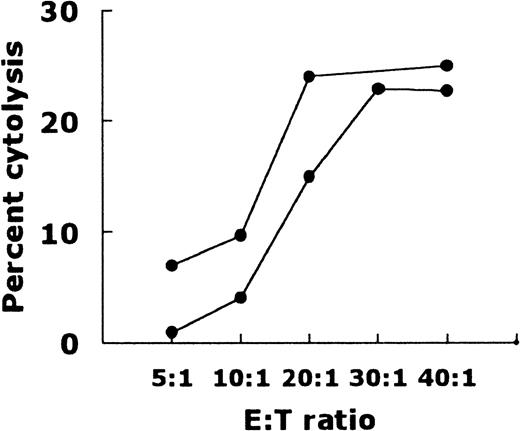
![Fig. 3. Effect of the anti-FcRII MoAb IV.3 (Fab fragments) and anti-FcRIII MoAb 3G8 (F[ab′]2 fragments) on the GM-CSF–stimulated neutrophil-mediated Lym-1 antibody-dependent cytolysis.51Cr-labeled Raji cells were at 2 × 104. The neutrophil-Raji cell ratio was 20:1. Lym-1 and GM-CSF were at 10 μg/mL and 1 ng/mL, respectively. The incubation time was 14 hours. (A) The lysis was 15.43 ± 6.17 (mean ± 1 SD, n = 4) with a median of 12.90 (confidence interval 95%, 5.61 to 25.24) in the absence of IV.3 and 0.02 ± 0.05 (mean ± 1 SD, n = 4) with a median of 0.00 (confidence interval 95%, −0.05 to 0.10) in the presence of 4 μg/mL IV.3. Cytolysis in the absence versus that in the presence of IV.3 was P = .0286. (B) The lysis was 16.34 ± 7.10 (mean ± 1 SD, n = 5) with a median of 14.10 (confidence interval 95%, 7.53 to 25.15) in the absence of 3G8 and 19.92 ± 11.43 (mean ± 1 SD, n = 5) with a median of 20.00 (confidence interval 95%, 5.73 to 34.11) in the presence of 4 μg/mL 3G8. Cytolysis in the absence versus that in the presence of 3G8 was P = 1.000.](https://ash.silverchair-cdn.com/ash/content_public/journal/blood/93/10/10.1182_blood.v93.10.3505.410k20_3505_3511/5/m_blod41020003x.jpeg?Expires=1769167315&Signature=HH17kwGgCPdrCD2ctcbNr8BHifH3wfqFBzNHAzX1Cs~B7ERJ7RWy~wzYIU8GvuCMiSuNYNOvu7kglHQBotaZSdfavuMiWrdwOBfEZEA1fiETPZaQUuf1PDKbWFhWeByQTpPwM5Hqo-J~KvBPSBAzLkm5cws4i2HcwiqD-~aBa5M6q~hIxgkbaIh4rK4xeXa9R1~9xfSdbSW7D5aUMQcmp~MZaqDbZ73ym~0pfdI9DOM2HSKLsINesBuD4Xh5FCRPdIsK9lW8j38AFSha2cqSsCOjrNVriBYxhjO75LtToXt970zWfuuRoqtGw2szBrwSUk3fzHMzNnmKLTTBp3kaag__&Key-Pair-Id=APKAIE5G5CRDK6RD3PGA)
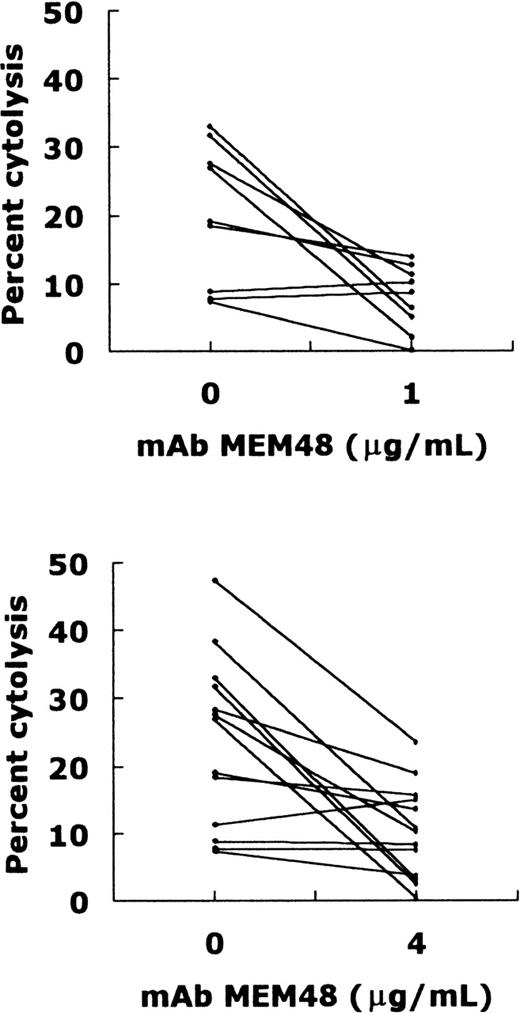

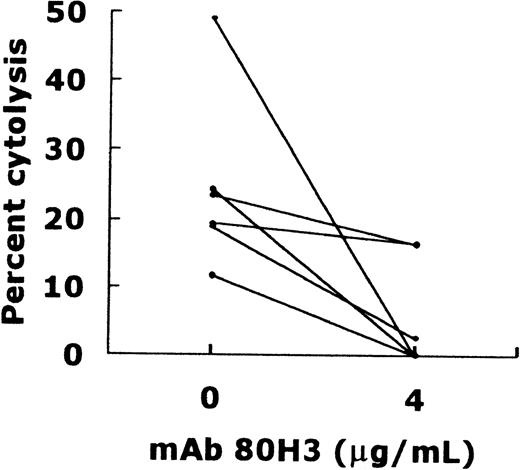
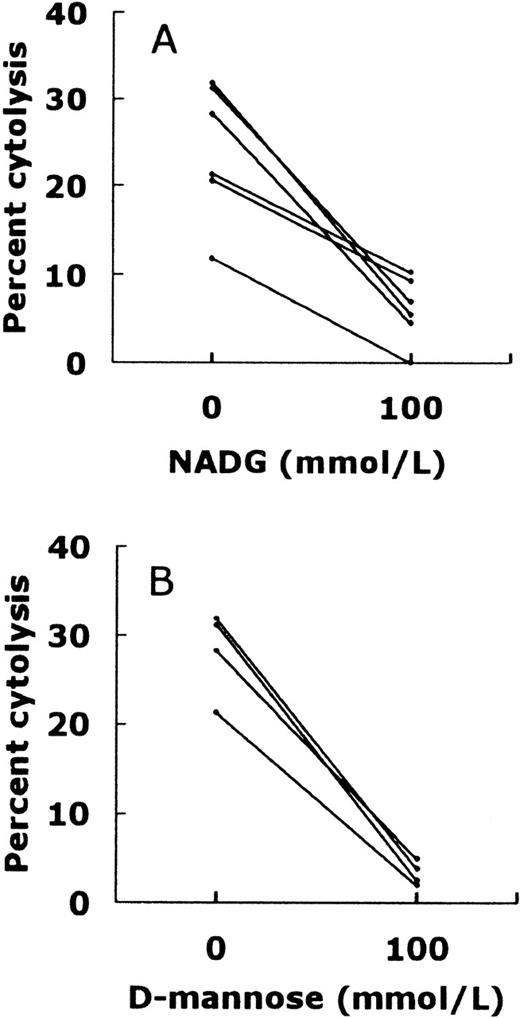
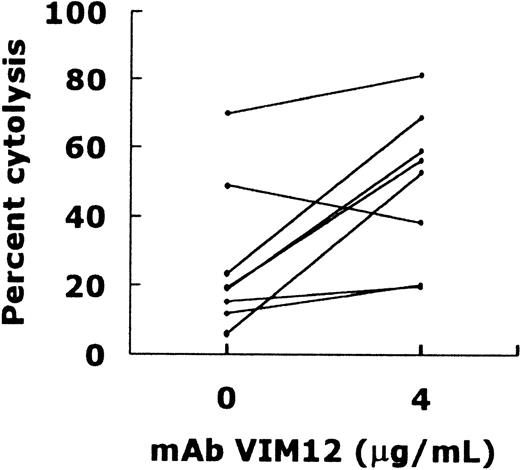
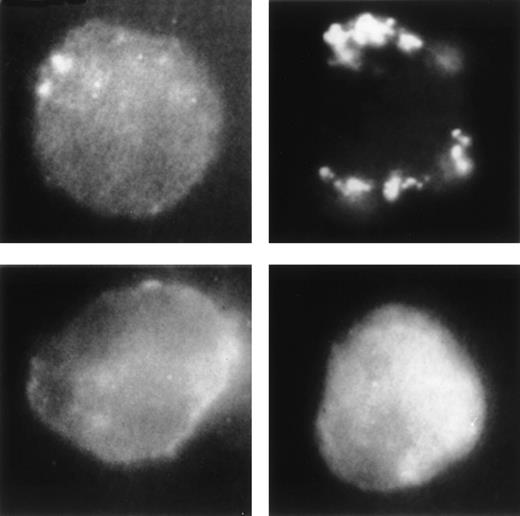
This feature is available to Subscribers Only
Sign In or Create an Account Close Modal